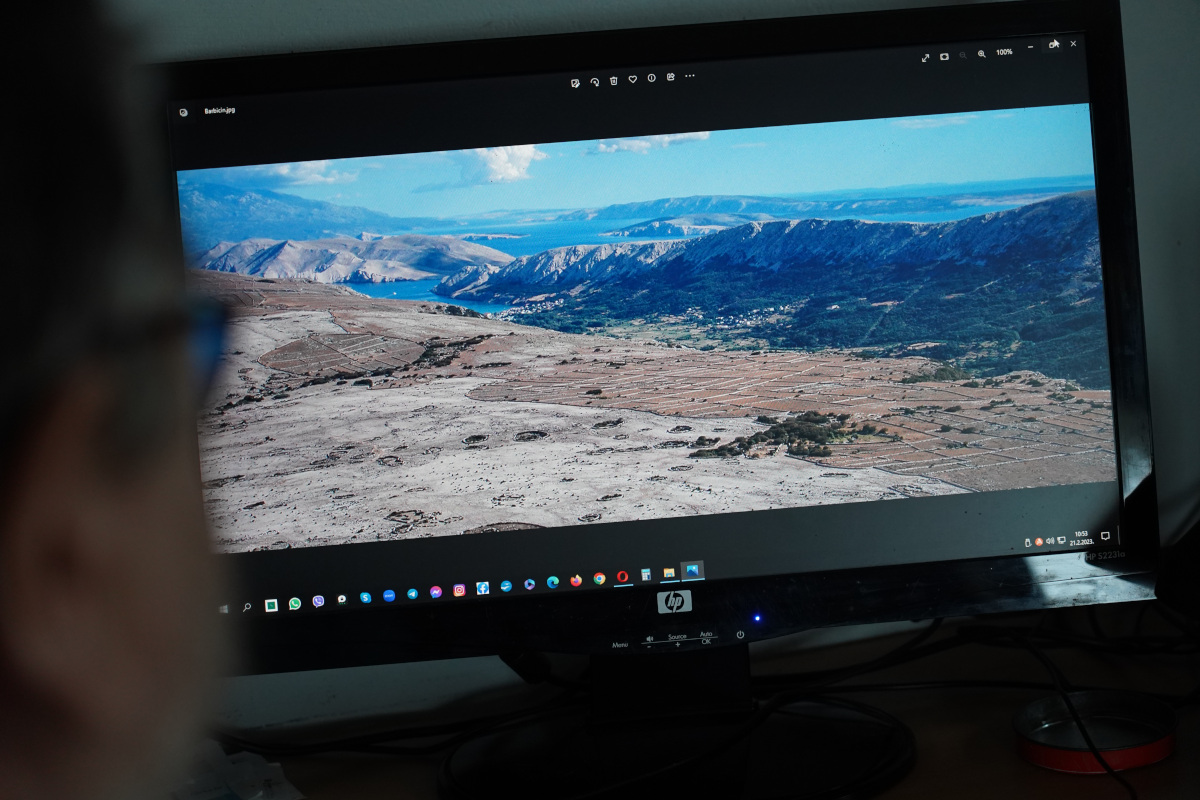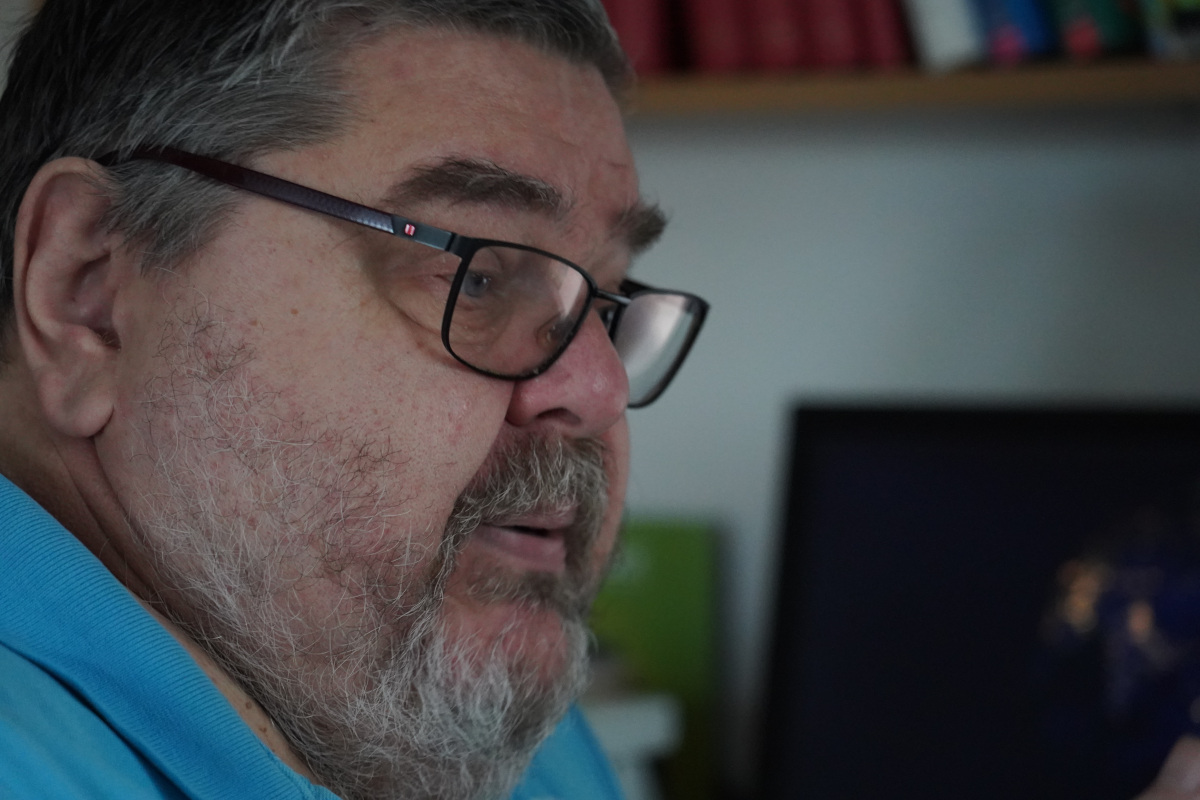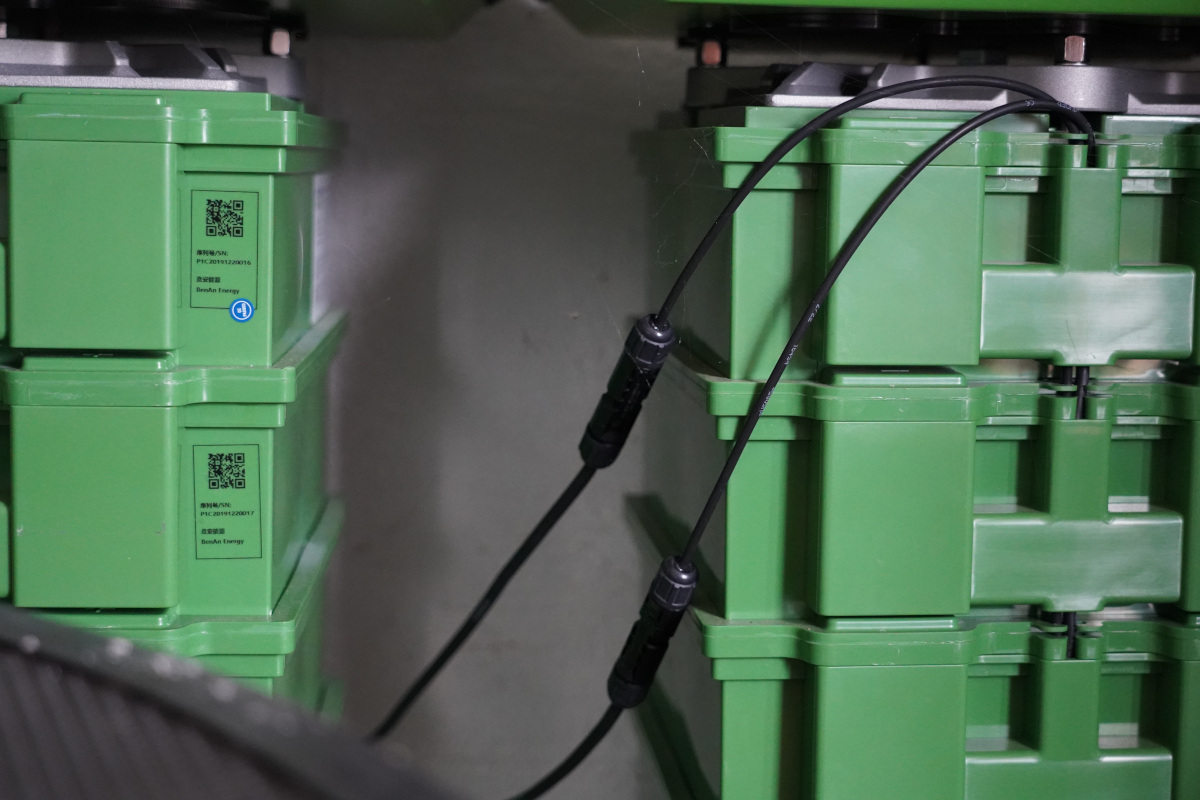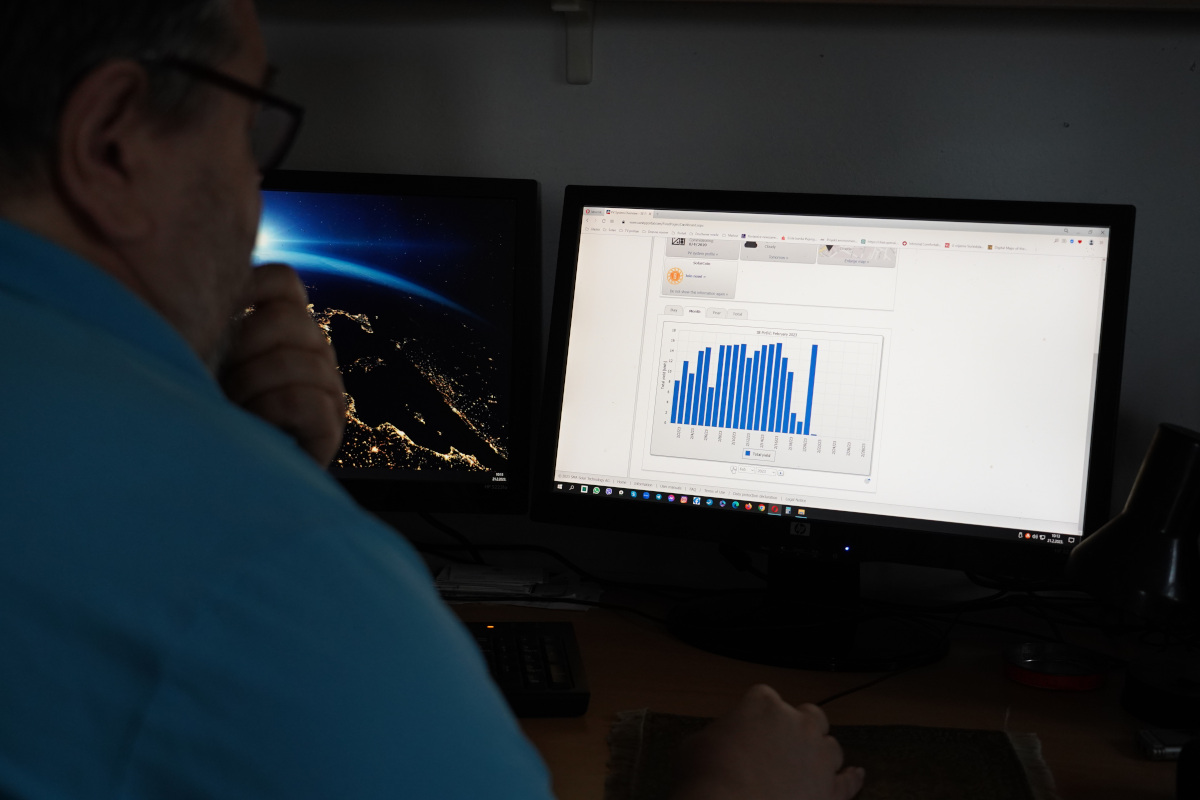
View of Krk, from Vjeran Piršić's PC - photo D. Sighele
Decarbonise, decentralise, democratise. These are the three Ds of a possible energy revolution that some citizens are carrying out on the Croatian island of Krk through the installation of many photovoltaic systems and the establishment of an energy community. An interview
Vjeran Piršić, originally from Rijeka, has lived on the island of Krk since 1972. He has a background as a mathematician, but he is a computer scientist by vocation: he has been working with software since 1986 and currently deals with intelligent networks (smart grids) and electro-energy systems. We met him.
“We are on the island of Krk, the northernmost and largest of the Croatian islands with its 408 km²”, says Piršić. “Twenty thousand people in the winter, one hundred and twenty thousand in the summer. After the war we started to think about which island we wanted. Some wanted to develop the island following the example of the Montenegrin coast, hence the urbanisation, the devastation… These people are still there, they say it is stupid that between Baška and Punat there are not at least five five-star resorts.
Immediately after the war there were only four of us thinking about sustainable development. We followed the [UN on Environment and Development] Conference in Rio in 1992, then tried to get in touch with the UNESCO office in Venice. In the following years many students arrived from Venice, two buses every winter, and in the period 1996-1999 they developed many projects. In 1999 the municipality of Omišalj was awarded the Council of Europe prize for the most sustainable municipality in the Mediterranean. It was a good time, but at a certain point we realised we had to change strategy".
How?
At that time we had loads of projects, but only on paper, nothing achieved. The situation changed around 2000, when the political decision was made to address the issue of waste management first. Two years later a study was commissioned, and the system was implemented in 2006. Today we separate more than 60% of waste, but the goal is to reach 80%. However, even 60% is an excellent result, considering that most tourists do not separate waste. Those who come from Ljubljana for example separate waste, but those from Zagreb or Rijeka don't, they are not used to. We have ten projects in this area, they work well, we are known for separate waste collection.
Who is “we”?
I am referring to the entire local community. Starting from the city council and the mayor, but also the private sector and civil society activists; the academic community has always supported us (I am thinking of the universities of Zagreb, Rijeka, Ljubljana, Trieste...), and even the Church.
At the time the first project regarding separate waste collection began, I was a municipal councillor in Omišalj. More than one hundred councillors voted in favour of the proposal to allocate five million Euros for the creation of a system in contrast with the national strategy, which at that time was focused on the compaction and incineration of waste. Basically waste was burned in incinerators, and then the ashes were stored in old empty oil fields. Those bales of waste at the entrance to the city of Varaždin, which recently led to the fall of the municipal administration, are a consequence of that system. We have always been in favour of separate waste collection and against incineration.
When did you start thinking about the topic of energy in Krk?
It all started in 2008, when a debate on a new energy strategy was started in Croatia. The proposal for a new national strategy was presented with great fanfare in Zagreb. After the presentation, however, we realised that they were playing us. They wanted to cancel the moratorium on the construction of new coal-fired thermoelectric power plants [approved by parliament in 2002, ed.], thus proposing a strategy centred on the transition - or rather the return - to coal: which necessarily had to be imported, because Croatia, unlike Poland for example, it does not have large coal reserves. The strategy was approved by parliament in September 2009, providing for the construction of two new thermoelectric power plants, in Plomin and Ploče.
It was all a sham. We therefore decided, at the beginning of 2009, to found “Solarni klaster Hrvatske” [The Croatian Solar Cluster], an association committed to the promotion of solar and green energy, and in May 2009 the first photovoltaic system was installed in Rijeka on roof of the town hall; in 2012 we founded the energy cooperative “Otok Krk” . Everything went very well until the arrival of Minister Igor Vrdoljak [Minister of Economy from 2012 to 2015 and then leader of the Croatian People's Party, ed.]: the state insisted on coal, so we were forced to abandon both projects that we were carrying out in that period.
The coal-centred strategy was then abandoned in 2018, and the state once again began funding solar energy projects. Meanwhile, in 2012 we learned of the results of a study carried out by some German companies and experts on how to make the island of Krk sustainable. According to this study, the island could satisfy 60% of its energy needs with the sun, 30% with the wind, and the remaining 10% with biogas or something similar. In these ways we could produce 150 GWh per year – enough for the local population, but also for tourists. We have also started thinking about switching to electric vehicles: today traffic, including ferries, is responsible for 52% of pollution on the island. We intend to focus on this between now and 2030.
Your house, here in Omišalj, is completely self-sufficient in terms of energy. Can you describe it to us?
First I installed a photovoltaic system. I calculated that the house consumed 8,000 kWh per year. To cover my needs I purchased a 6.8 kW system, spending around 8000 Euros. 60% of the expense was reimbursed to me non-repayably by the Environmental Protection Fund , supported among others by the Regional Ministry for Development and European Funds . Then I purchased batteries for storage, again receiving support from the Fund, and I installed new windows and an external thermal coat 10 cm thick. I connected a heat pump to the existing central heating system - with radiators; I got a smart grid ready system, which allows me to save 60% on heating.
For a typical house on the island of Krk the entire investment, including the redevelopment of the facades, ranges from 50,000 to 100,000 Euros. However, sticking to energy efficiency interventions [excluding the cladding, ed.] requires between 30,000 and 50,000 Euros. Of course, it is not easy to obtain those figures, but it becomes possible to do so by moving one step at a time, thanks to the Fund's contributions and the savings resulting from the investments made.
Since I have the photovoltaic system I no longer spend 1000 Euros a year on electricity, but 100. A normal house consumes around 5,000 kWh per year and spends around 5,600 Euros (of which only 2,600 are for energy consumed, the rest goes towards VAT, the grid, etc.). If, however, you produce electricity for your own consumption, you consume 30% less and the cost of energy is halved.
Another issue is the ability to accumulate energy, not just produce it...
I purchased salt water batteries, which are easily recyclable and, in combination with classic batteries, can withstand 5000 charge-discharge cycles, so they last more than fifteen years. So I accumulate the surplus of energy produced and then use it at night, or possibly during the day if I really need it.
In Croatia there is an electricity stock exchange (CROPEX ): the price of energy varies and has two daily peaks. For example, it happens that at 4 in the morning electricity costs 50 Euros, then at 7am it exceeds 200 Euros, and then drops in the afternoon, reaching the peak again at 8pm. So, during the night I accumulate cheap energy in my batteries , then I sell it in the morning when the price goes up. During the day, however, I fill the batteries with the energy produced by my photovoltaic system, and then sell it in the evening when the price increases. This way I can earn around 300-500 Euros a month.
By the end of this year I will have a 15 kW photovoltaic system, batteries with a storage capacity of 30 kWh, two electric cars, and two heat pumps. At that point I will be truly self-sufficient, even overcoming the critical phase of December, when there is no sun and temperatures drop below zero.
Are the contributions paid by the Fund still in force?
The National Fund routinely publishes calls for funding under very clear conditions. For a normal house, the Fund offers a 40% reimbursement for investments in energy efficiency, which rises to 60% for islands and 80% for areas devastated during the war.
How many houses on the island have a photovoltaic system today?
Currently [data from December 2022, ed.] in Krk there are 175 individual houses with small photovoltaic systems, mostly installed thanks to contributions from the Fund. However, not all have storage batteries, so some produce energy for self-consumption and deliver any excess energy to the grid. In the smaller villages many homes are not connected to the grid: in addition to the panels they have batteries. We hope that by the end of this year the number of homes with photovoltaic systems will double.
In this context, what is the value of community?
The goal is to connect all homes that have photovoltaic to a smart grid, thus creating an energy community, as also encouraged by the EU. Ultimately most homes should have a 10-30kW system depending on the size of the building, some will also have batteries for storage, most households will have electric cars and a smart heat pump. We also aim to develop software that allows us to further reduce the price and energy consumption.
Even if I could now disconnect from the network, for me it is always better to collaborate. I think of a collaboration on two levels. First, it would be advisable to have large municipal photovoltaic systems: at the moment I produce energy at a price of 42 Euros per MWh, but large systems can produce at 25 Euros per MWh. Second, it serves the energy community.
Being able to count on an energy community means, for example, that if a school produces a lot of solar energy in the summer and does not consume it - being closed for holidays - it can give that energy to a hotel. On the contrary, in winter it could be the hotel which, being in the low season, gives energy to the school. Another example: holiday homes used only on weekends can give the energy they produce from Monday to Friday to a factory or permanent residents. The basic idea is to commit to ensuring that the inhabitants of the island, the common people, are able to have, each in their own home, a system that leads to energy self-sufficiency.
How close is Krk to energy independence?
The energy community project has been underway for some time: the ultimate goal is to install 1000 small individual photovoltaic systems on the island, plus two large systems (and possibly 100 medium-sized ones), so that we can produce a sufficient amount of energy to the entire island – including means of transport, therefore cars and electric ferries. Citizens will have access to electricity at a much lower price than the current one, and in the summer, when we produce excess energy, we will be able to sell it.
With one of the plants in Krk we are already at a good stage. The idea is to build a large 10 MW photovoltaic plant on a plateau overlooking the city of Baška. This project risked being sold to some large company, but we managed to convince the mayor and the city council to build the plant independently: in 2019 the company Otok Krk Energija was founded, of which the municipality of Baška is the 100% owner. The municipality invested its own money and some European funds in developing the project; the state granted us 15 hectares of land for free use for twenty-five years. We aim to implement the project in two phases (5 MW + 5 MW), financing the first phase with a loan and then involving widespread shareholders through an energy cooperative.
The county had included five large 10 MW photovoltaic systems in the master plan, one on each island and one on the mainland. The plants on the islands of Rab and Lošinj are also already under construction; in Cres the project was assigned to HEP, while on the mainland the work has not yet started.
However, some bureaucratic impediments remain...
Croatia made several mistakes in transposing the EU RED II Directive. First, it stipulated that an energy community must be limited to the territory of a municipality, therefore it cannot extend over an entire island. Second, that it can only be connected to a low voltage substation. And third, that it must be a non-profit organisation. With the help of some jurists, we have proposed a series of changes to the law , asking the state to remedy the mistakes made – which mean that, for example, in Greece today there are over 600 energy communities while in Croatia there are none.
What is the value of energy communities?
They are the engine of a possible energy transition which should mean: decarbonisation, digitalisation (thanks to the smart grid), decentralisation (many small prosumers), and democratisation. This is a fight between big companies and us small, simple citizens. The European Union started out as a coal and steel community, right? If we [the former Yugoslav countries, ed.] also managed to collaborate more in the renewable energy sector, perhaps we wouldn't fight so often. We don't necessarily have to unite again, but by working together we can at least ease tensions.
Smart Grid
“For all this to work, we need software that we call smart grid or intelligent network, which I am currently in charge of”, says Vjeran Piršić. “The software uses blockchain technology, so for each kWh we will know who consumed it and how. The smart grid will autonomously understand that - for example - every Friday many people arrive on the island with electric cars, and therefore there must be a sufficient amount of energy in the storage batteries to recharge those cars.
Just as it will understand that in case of rain many people will not spend the weekend in Krk, and therefore the excess energy can be supplied to the local population. We have already implemented a pilot project on the island of Unije as part of a European Horizon 2020 programme"
Fotovoltaico e fondi europei
Croatia is paying a lot of attention to the production of renewable energy. In the 2021-2027 period it plans to invest 20 million Euros in the "Energy and climate change" sector, including 17 from European funds. In this context, the number of projects involving the installation of new photovoltaic systems has grown. In the capital, for example, the “Solizag – Working together for a Green Europe ”“ project envisages an increase in the production of renewable energy in public and municipally-owned structures. The construction of the solar system for use by the Sv. Ivan psychiatric clinic was completed in September 2023: with a capacity of 300 kW, it will lead to annual savings in electricity expenditure of around 50,000 Euros, halving the current average expenditure.
This content is published in the context of the "Energy4Future" project co-financed by the European Union (EU). The EU is in no way responsible for the information or views expressed within the framework of the project. The responsibility for the contents lies solely with OBC Transeuropa. Go to the "Energy4Future"









